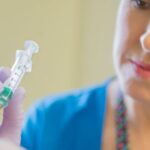Needlestick injury protection, according to a medical director
In this interview series, you will hear first-hand experiences of how hospitals are protecting their staff, managing reporting, implementing risk assessment procedures and how safety-engineered devices (SEDs) are being implemented to help meet the challenge of needlestick injuries (NSIs).
The following video on needlestick injury protection features Prof. Gabriella De Carli, Medical Director, in the Department of Epidemiology and Pre-Clinical Research at the Lazzaro Spallanzani National Institute for Infectious Diseases in Rome, Italy. She delivered a presentation on the “Transposition and application of the European Directive in Italy: where are we?” at the 7th European Biosafety Summit in 2018.
1. How can SEDs be improved?
Prof. De Carli would like SEDs to be better adapted to the handling difficulties of healthcare professionals (HCPs). She recommends SEDs with automatic activation, even if they can’t be used for every procedure.
In addition to this, she expects all components of each SED to be well-crafted. She also wants SEDs to not be significantly larger than conventional devices to prevent increased waste. Prof. De Carli feels that activation should be irreversible.
Some SEDs can help prevent NSIs, but they may lead to blood exposure. So, she thinks that minimising the risk of exposure as well as preventing NSIs should be taken into consideration when designing these devices.
2. What should be done to improve NSI reporting?
According to Prof. De Carli, HCPs need to see the benefits of reporting NSIs. If nothing is done after an incident, they will be less likely to report the next one. Therefore, it’s important that healthcare facility leaders show that the problem is being addressed by:
- Offering post-exposure care
- Investigating the incident
- Providing NSI prevention training
She feels this will encourage HCPs to report incidents in the future.
More on this topic: European Biosafety Network webinar on preventing sharps injuries, Medical Device Regulation and safety mechanisms in medical devices
3. How can HCPs be better protected from NSIs?
Government Ministries of Health from across Europe should carry out a campaign for HCPs, healthcare facility leaders and the general public to raise awareness by letting HCPs, who have been injured or infected, tell their stories.
Along with this, she thinks the needlestick injury protection campaign should show data and recommend possible actions to take to prevent NSIs. HCPs are dedicated to caring for patients, but they want to be protected when providing this care.
More on this topic: 3 keys to preventing needlestick injuries: locate, train, assess
Register to access the video interview




